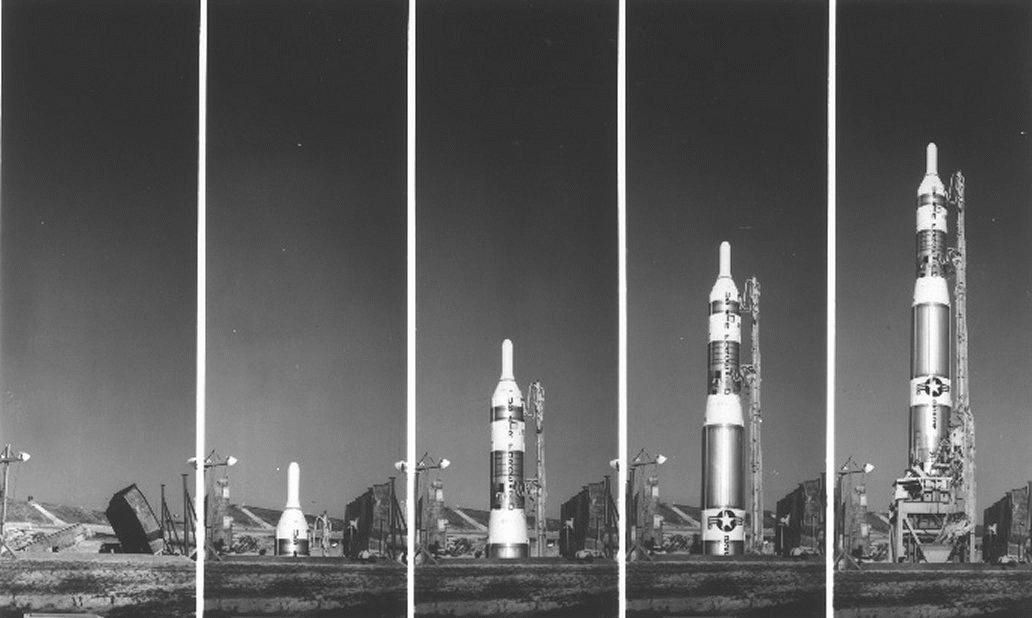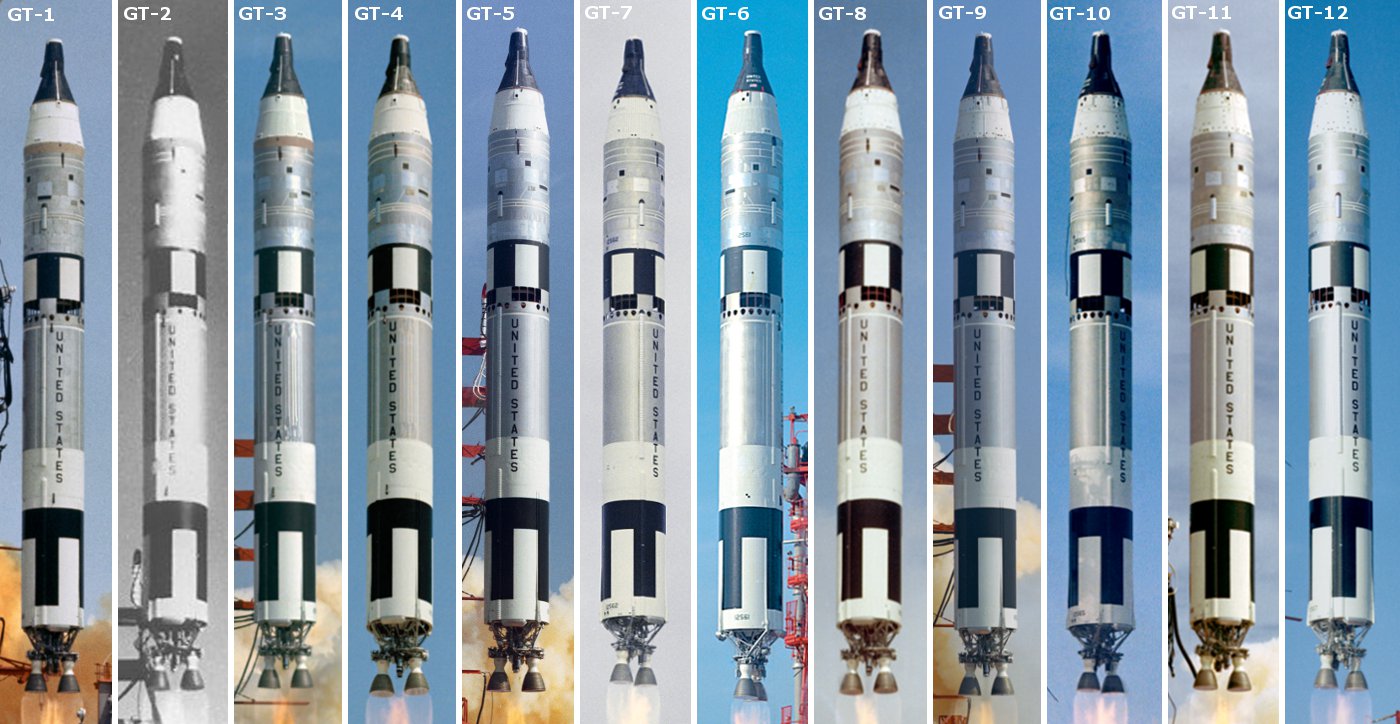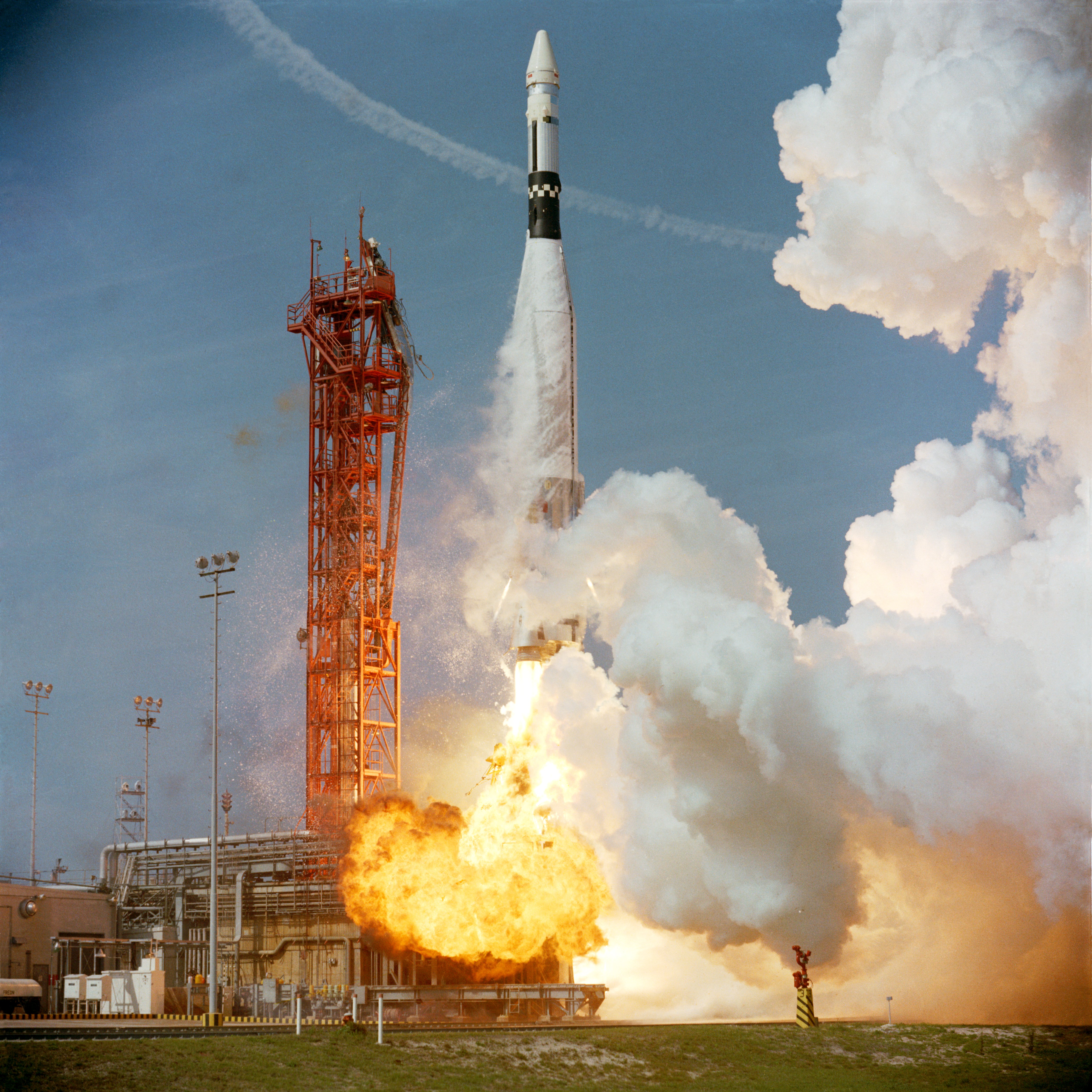|
LC-19
Launch Complex 19 (LC-19) is a deactivated launch site on Cape Canaveral Space Force Station, Florida used by NASA to launch all of the Gemini crewed spaceflights. It was also used by uncrewed Titan I and Titan II missiles. LC-19 was in use from 1959 to 1966, during which time it saw 27 launches, 10 of which were crewed. The first flight from LC-19 was on August 14, 1959 and ended in a pad explosion, extensively damaging the facility, which took a few months to repair. The first successful launch from LC-19 was also a Titan I, on February 2, 1960. After being converted for the Titan II ICBM program in 1962, LC-19 was later designated for the Gemini flights. After the program concluded in December 1966, LC-19 was closed down. The Gemini white room from the top of the booster erector has been partially restored and is on display at the Air Force Space and Missile Museum located at Complex 26. Gallery Image:Complex19.jpg, Diagram of Complex 19. Image:Complex19block.jpg, ... [...More Info...] [...Related Items...] OR: [Wikipedia] [Google] [Baidu] |
Titan I
The Martin Marietta SM-68A/HGM-25A Titan I was the United States' first multistage intercontinental ballistic missile (ICBM), in use from 1959 until 1962. Though the SM-68A was operational for only three years, it spawned numerous follow-on models that were a part of the U.S. arsenal and space launch capability. The Titan I was unique among the Titan models in that it used liquid oxygen and RP-1 as propellants; all subsequent versions used storable propellants instead. Originally designed as a backup in case the U.S. Air Force's SM-65 Atlas missile development ran into problems, the Titan was ultimately beaten into service by Atlas. Deployment went ahead anyway to more rapidly increase the number of missiles on alert and because the Titan's missile silo basing was more survivable than Atlas. The succeeding LGM-25C Titan II served in the U.S. nuclear deterrent until 1987 and had increased capacity and range in addition to the different propellants. History By January 1955, the ... [...More Info...] [...Related Items...] OR: [Wikipedia] [Google] [Baidu] |
HGM-25A Titan I
The Martin Marietta SM-68A/HGM-25A Titan I was the United States' first multistage intercontinental ballistic missile (ICBM), in use from 1959 until 1962. Though the SM-68A was operational for only three years, it spawned numerous follow-on models that were a part of the U.S. arsenal and space launch capability. The Titan I was unique among the Titan models in that it used liquid oxygen and RP-1 as propellants; all subsequent versions used storable propellants instead. Originally designed as a backup in case the U.S. Air Force's SM-65 Atlas missile development ran into problems, the Titan was ultimately beaten into service by Atlas. Deployment went ahead anyway to more rapidly increase the number of missiles on alert and because the Titan's missile silo basing was more survivable than Atlas. The succeeding LGM-25C Titan II served in the U.S. nuclear deterrent until 1987 and had increased capacity and range in addition to the different propellants. History By January 1955, th ... [...More Info...] [...Related Items...] OR: [Wikipedia] [Google] [Baidu] |
Gemini 10
Gemini 10 (officially Gemini X) With Gemini IV, NASA changed to Roman numerals for Gemini mission designations. was a 1966 crewed spaceflight in NASA's Gemini program. It was the 8th crewed Gemini flight, the 16th crewed American flight, and the 24th spaceflight of all time (includes X-15 flights over ). During the mission, flown by John Young and future Apollo 11 Command Module Pilot Michael Collins, Collins became the first person to perform two extravehicular activities. Crew Backup crew Support crew * Edwin E. "Buzz" Aldrin (Houston CAPCOM) * L. Gordon Cooper Jr. (Cape and Houston CAPCOM) Jim Lovell and Buzz Aldrin had originally been named the backup crew, but after Charles Bassett and Elliot See died in a T-38 crash, they were moved to the backup crew for Gemini 9 and Alan Bean and Clifton Williams were moved to the Gemini 10 flight. Mission parameters *Mass: *Perigee: *Apogee: *Inclination: 28.87° *Period: 88.79 min Docking *Docked: July 19, 1966 - 04:15:00 ... [...More Info...] [...Related Items...] OR: [Wikipedia] [Google] [Baidu] |
Titan II GLV
The Titan II GLV (Gemini Launch Vehicle) or Gemini-Titan II was an American expendable launch system derived from the Titan II missile, which was used to launch twelve Gemini missions for NASA between 1964 and 1966. Two uncrewed launches followed by ten crewed ones were conducted from Launch Complex 19 at the Cape Canaveral Air Force Station, starting with Gemini 1 on April 8, 1964. The Titan II was a two-stage liquid-fuel rocket, using a hypergolic propellant combination of Aerozine 50 fuel and nitrogen tetroxide oxidizer. The first stage was powered by an LR87 engine (with two combustion chambers and nozzles, fed by separate sets of turbomachinery), and the second stage was propelled by an LR-91 engine. Modifications from the Titan II missile In addition to greater payload capability, the Titan II promised greater reliability than the Atlas LV-3B, which had been selected for Project Mercury, because Titan's hypergolic-fueled engines contained far fewer components. Several m ... [...More Info...] [...Related Items...] OR: [Wikipedia] [Google] [Baidu] |
Gemini 9A
Gemini 9A (officially Gemini IX-A) With Gemini IV, NASA changed to Roman numerals for Gemini mission designations. was a 1966 crewed spaceflight in NASA's Gemini program. It was the seventh crewed Gemini flight, the 13th crewed American flight and the 23rd spaceflight of all time (includes X-15 flights over ). The original crew for Gemini 9, command pilot Elliot See and pilot Charles Bassett, were killed in a crash on February 28, 1966, while flying a T-38 jet trainer to the McDonnell Aircraft plant in St. Louis, Missouri to inspect their spacecraft. Their deaths promoted the backup crew, Thomas P. Stafford and Eugene Cernan, to the prime crew. The mission was renamed Gemini 9A after the original May 17 launch was scrubbed when the mission's Agena Target Vehicle was destroyed after a launch failure. The mission was flown June 3–6, 1966, after launch of the backup Augmented Target Docking Adaptor (ATDA). Stafford and Cernan rendezvoused with the ATDA, but were unable to doc ... [...More Info...] [...Related Items...] OR: [Wikipedia] [Google] [Baidu] |
Gemini 6A
Gemini 6A (officially Gemini VI-A) With Gemini IV, NASA changed to Roman numerals for Gemini mission designations. was a 1965 crewed United States spaceflight in NASA's Gemini program. The mission, flown by Wally Schirra and Thomas P. Stafford, achieved the first crewed rendezvous with another spacecraft, its sister Gemini 7. Although the Soviet Union had twice previously launched simultaneous pairs of Vostok spacecraft, these established radio contact with each other, but they had no ability to adjust their orbits in order to rendezvous and came no closer than several kilometers of each other, while the Gemini 6 and 7 spacecraft came as close as one foot (30 cm) and could have docked had they been so equipped. Gemini 6A was the fifth crewed Gemini flight, the 13th crewed American flight, and the 21st crewed spaceflight of all time (including two X-15 flights over ). Crew Backup crew This was the prime crew of Gemini 3 Support crew * Charles A. Bassett II (Houston ... [...More Info...] [...Related Items...] OR: [Wikipedia] [Google] [Baidu] |
Gemini 4
Gemini 4 (officially Gemini IV) With Gemini IV, NASA changed to Roman numerals for Gemini mission designations. was the second crewed spaceflight in NASA's Project Gemini, occurring in June 1965. It was the tenth crewed American spaceflight (including two X-15 flights at altitudes exceeding ). Astronauts James McDivitt and Ed White circled the Earth 66 times in four days, making it the first US flight to approach the five-day flight of the Soviet Vostok 5. The highlight of the mission was the first space walk by an American, during which White floated free outside the spacecraft, tethered to it, for approximately 23 minutes. The flight also included the first attempt to make a space rendezvous as McDivitt attempted to maneuver his craft close to the Titan II upper stage which launched it into orbit, but this was not successful. The flight was the first American flight to perform many scientific experiments in space, including use of a sextant to investigate the use of celestial ... [...More Info...] [...Related Items...] OR: [Wikipedia] [Google] [Baidu] |
Gemini Program
Project Gemini () was NASA's second human spaceflight program. Conducted between projects Mercury and Apollo, Gemini started in 1961 and concluded in 1966. The Gemini spacecraft carried a two-astronaut crew. Ten Gemini crews and 16 individual astronauts flew low Earth orbit (LEO) missions during 1965 and 1966. Gemini's objective was the development of space travel techniques to support the Apollo mission to land astronauts on the Moon. In doing so, it allowed the United States to catch up and overcome the lead in human spaceflight capability the Soviet Union had obtained in the early years of the Space Race, by demonstrating: mission endurance up to just under 14 days, longer than the eight days required for a round trip to the Moon; methods of performing extra-vehicular activity (EVA) without tiring; and the orbital maneuvers necessary to achieve rendezvous and docking with another spacecraft. This left Apollo free to pursue its prime mission without spending time developin ... [...More Info...] [...Related Items...] OR: [Wikipedia] [Google] [Baidu] |
Gemini 11
Gemini 11 (officially Gemini XI) With Gemini IV, NASA changed to Roman numerals for Gemini mission designations. was the ninth crewed spaceflight mission of NASA's Project Gemini, which flew from September 12 to 15, 1966. It was the 17th crewed American flight and the 25th spaceflight to that time (includes X-15 flights over ). Astronauts Charles "Pete" Conrad Jr. and Richard F. Gordon Jr. performed the first direct-ascent (first orbit) rendezvous with an Agena Target Vehicle, docking with it 1 hour 34 minutes after launch; used the Agena rocket engine to achieve a record high-apogee Earth orbit; and created a small amount of artificial gravity by spinning the two spacecraft connected by a tether. Gordon also performed two extra-vehicular activities for a total of 2 hours 41 minutes. Crew Backup crew Support crew *Clifton C. Williams Jr. (Cape CAPCOM) * John W. Young (Houston CAPCOM) *Alan L. Bean (Houston CAPCOM) Mission parameters *Mass: Highest orbit (follo ... [...More Info...] [...Related Items...] OR: [Wikipedia] [Google] [Baidu] |
Gemini 8
Gemini 8 (officially Gemini VIII) With Gemini IV, NASA changed to Roman numerals for Gemini mission designations. was the sixth crewed spaceflight in NASA's Gemini program. It was launched on March 16, 1966, and was the 14th crewed American flight and the 22nd crewed spaceflight overall. The mission conducted the first docking of two spacecraft in orbit, but also suffered the first critical in-space system failure of a U.S. spacecraft which threatened the lives of the astronauts and required an immediate abort of the mission. The crew returned to Earth safely. Flown by pilot David Scott and command pilot Neil Armstrong, the flight marked the second time a U.S. civilian flew into space and the first time a U.S. civilian flew into orbit. Background Command pilot Neil Armstrong resigned his commission in the U.S. Naval Reserve in 1960. His flight marked the second time a U.S. civilian flew into space (after Joe Walker on X-15 Flight 90), and the first time a U.S. civilian flew in ... [...More Info...] [...Related Items...] OR: [Wikipedia] [Google] [Baidu] |
Gemini 7
Gemini 7 (officially Gemini VII) With Gemini IV, NASA changed to Roman numerals for Gemini mission designations. was a 1965 crewed spaceflight in NASA's Gemini program. It was the fourth crewed Gemini flight, the twelfth crewed American spaceflight, and the twenty-first crewed spaceflight including Soviet flights and X-15 flights above the Kármán line. The crew of Frank Borman and Jim Lovell spent nearly 14 days in space, making a total of 206 orbits. Their spacecraft was the passive target for the first crewed space rendezvous performed by the crew of Gemini 6A. Crew Backup crew Support crew * Charles Bassett (Houston CAPCOM) * Alan Bean (Cape CAPCOM) * Eugene Cernan (Houston CAPCOM) * Elliot See (Houston CAPCOM) Mission parameters * launch Mass: , landing mass: At December 9 epoch, five days after launch: * Perigee: * Apogee: * Inclination: 28.9° * Period: 90.54 min Stationkeeping with GT-6A * Start: December 15, 1965 19:33 UTC * End: December 16, 1965 00:52 UTC ... [...More Info...] [...Related Items...] OR: [Wikipedia] [Google] [Baidu] |
Gemini 5
Gemini 5 (officially Gemini V) With Gemini IV, NASA changed to Roman numerals for Gemini mission designations. was a 1965 crewed spaceflight in NASA's Project Gemini. It was the third crewed Gemini flight, the eleventh crewed American spaceflight (including two X-15 flights above ), and the nineteenth human spaceflight of all time. It was also the first time an American crewed space mission held the world record for duration, set on August 26, 1965, by breaking the Soviet Union's previous record set by Vostok 5 in 1963. This record might have been one day longer; however, Gemini V was cut short, due to the approach of Hurricane Betsy. Crew Backup crew Support crew * Edwin E. "Buzz" Aldrin (Houston CAPCOM) * Virgil I. "Gus" Grissom (Cape CAPCOM) * James A. McDivitt (Houston CAPCOM) Mission parameters * Mass: * Perigee: * Apogee: * Inclination: 32.61° * Period: 89.59 min * REP (Rendezvous Evaluation Pod) sub-satellite: On August 21, 1965, at 16:07:15 UTC, the REP was rel ... [...More Info...] [...Related Items...] OR: [Wikipedia] [Google] [Baidu] |











